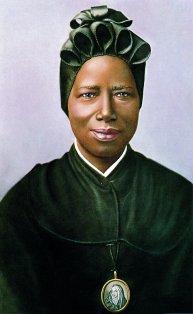- Josephine Bakhita
Infobox Saint
name=Josephine Bakhita
imagesize=180px
caption= Josephine Bakhita, Institute of the Daughters of the Canossian charity
birth_date=1869
death_date=8 February 1947
feast_day=8 February
venerated_in=Roman Catholic Church
birth_place=Olgossa, Darfur, Sudan
death_place=Italy
titles=
beatified_date=17 May 1992
beatified_place=
beatified_by= Pope John Paul II
canonized_date=1 October 2000
canonized_place=Saint Peter's Basilica, Rome,
canonized_by=Pope John Paul II
attributes=
patronage=Sudan
major_shrine=
suppressed_date=
issues=Saint Josephine Bakhita (1869 –
February 8 1947 ) is aRoman Catholic saint .Early life
Bakhita was born to a locally important family in
Olgossa , a village in the westernSudan ese region ofDarfur . Her father was the brother of a tribal chief. At the age of seven she was kidnapped byArab slave tradersFact|date=May 2008 and over the course of the next eight years was sold and resold five times in the markets ofEl Obeid andKhartoum Fact|date=May 2008. The trauma of her abduction caused her to forget her own name, and the name we know her by is a compound of the name given her by the slavers ("bakhita", the Arabic word forluck y) and the Christian name she took in adulthood Fact|date=May 2008 She was also forcibly converted toIslam . [cite book |title=Their Kingdom Come: Inside the Secret World of Opus Dei |last=Hutchison |first=Robert A. |authorlink= |coauthors= |year=1999 |publisher=St. Martin's Press |location= |isbn=0312193440 |pages=7 - Sister Josephine Bakhita had been converted by force to Islam and then, freedom restored, had chosen Christianity.]Life as a Slave
Bakhita suffered much brutality during her captivity. On one occasion, one of her owner's sons beat her so severely that she spent a month unable to move from a straw bed. She later recalled that her most terrifying memory was of her fourth owner, an Ottoman Army officer, having her (in common with all his other slaves) marked as "his" by a process resembling both
scarification andtattoo ing. Her memoirs, written in Italian many years later, recall that a dish of white flour, a dish of salt and a blade were brought by a woman, who drew patterns on her skin and then cut deeply along the lines before filling the wounds with salt and flour to ensure permanent scarring. More than sixty patterns were cut into her breasts, belly, and arms. [ [http://www.afrol.com/archive/josephine_bakhita.htm#slavery Biography from Afrol.com] ]Conversion
Her final owner was an Italian diplomat, Callisto Legnani. He and his friend, Augusto Michieli, brought her to
Italy . She became nanny to the Michieli's daughter, Mimmina. In 1888 or 1889 Bakhita and Mimmina were left in the custody of the Canossian Sisters inVenice while the Michielis moved to theRed Sea on business. In 1890 she was baptised at her own instigation, and took the Christian name Giuseppina Margarita.Fact|date=May 2008Freedom
When the Michielis returned to collect her and their daughter, Bakhita did not want to leave. Signora Michieli tried to force the issue, but the superior of the school that Bakhita and Signorina Mimmina had attended in Venice complained to the authorities. An Italian court ruled that since Sudan had outlawed slavery before Bakhita's birth, and since in any case Italian law did not recognise slavery, Bakhita had never in fact been a slave. Bakhita had now reached the age of majority, and she found herself in control of her own destiny for the first time in her life. She chose to remain with the Canossians.
Nun
In 1896 she joined the sisters permanently, and, in 1902, she was assigned to a house in
Schio [ [http://maps.google.com/maps?q=45.715289,11.360206&z=12 Google map of Schio] ] in the northern Italian province ofVicenza , where she spent the rest of her life. Her only extended time away from Schio was between 1935 and 1938, a period she spent in helping prepare young sisters for work in Africa.During her 45 years in
Schio , Josephine was usually employed as portress (door keeper) of her house, and so was in frequent contact with the local community. Her gentleness, calming voice, and ever-present smile became well known and Vicenzans still refer to her as "la nostra madre moretta" ("our little brown mother"). Her special charisma and reputation for sanctity were noticed by her order, and she was instructed to publish her memoirs and to give talks about her experiences; these made her famous throughout Italy. Her last years were marked by pain and sickness, but she retained her cheerfulness, and if asked how she was, would always smile and answer "as the Master desires".Illness and Death
In the extremity of her last days her mind was driven back to the years of her slavery and in her delirium she would cry out "Please, loosen the chains ... they are so heavy". Giuseppina died on
February 8 ,1947 . For three days her body lay on display while thousands of people arrived to pay their respects.Legacy and Canonization
The calls for her
canonization began immediately, and the process began in 1959, only twelve years after her death. OnDecember 1 ,1978 ,Pope John Paul II declared Giuseppina "Venerabilis", the first step towards canonization. OnMay 17 ,1992 , she was declared "Blessed" and givenFebruary 8 as her feast day. OnOctober 1 ,2000 , she was canonized and became Saint Josephine Bakhita. She is venerated as a modern African saint, and as a saint with a special relevance to slavery and oppression. She has been adopted as thepatron saint of Sudan.Quotation
[ [http://www.vatican.va/news_services/liturgy/saints/ns_lit_doc_20001001_giuseppina-bakhita_en.html Biography from the Vatican Website] ]
References
*Biography from the Vatican website: [http://www.vatican.va/news_services/liturgy/saints/ns_lit_doc_20001001_giuseppina-bakhita_en.html English] [http://www.vatican.va/news_services/liturgy/saints/ns_lit_doc_20001001_giuseppina-bakhita_fr.html French] [http://www.vatican.va/news_services/liturgy/saints/ns_lit_doc_20001001_giuseppina-bakhita_it.html Italian] [http://www.vatican.va/news_services/liturgy/saints/ns_lit_doc_20001001_giuseppina-bakhita_po.html Portuguese]
* [http://saints.sqpn.com/saintj84.htm A short biography] from Patron Saints Index
* [http://www.afrol.com/archive/josephine_bakhita.htm A longer biography from afrol.com]
* [http://www.vatican.va/holy_father/benedict_xvi/encyclicals/documents/hf_ben-xvi_enc_20071130_spe-salvi_en.html A brief biography] inPope Benedict XVI 's encyclical "Spe Salvi ", paragraph 3
* [http://www.canossiansisters.org/who.html Canossian Daughters of Charity]
* [http://www.cshi.com/aboutUs/bakhita.html Canossian School]Notes
Wikimedia Foundation. 2010.
